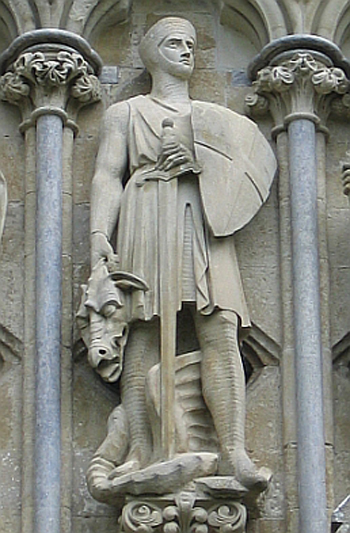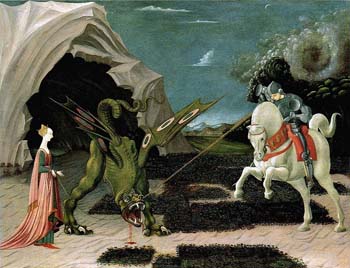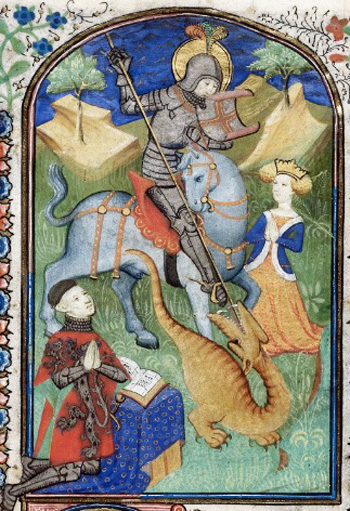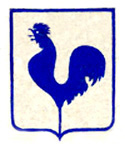Stories & Legends
 |
 |
 |
 |
 |
 |
 |
St. George Slays the Dragon
.
Whenever he approached the city he poisoned the people with his breath and, therefore, the people of the city gave him two sheep to eat every day so that he would do no harm to the people.
But the flock dwindled away, and the dragon’s wrath rose, until an ordinance was made that the children and young people of the town should be chosen by lottery to feed the dragon. Whoever the lot fell upon, wealthy or poor, he or she was delivered to the dragon.

St. George, Patron Saint of England,
holding the dragon's head
After some time the lot fell upon the King's daughter, the Princess Cleodolinda. The sorrowful King said to his people: "For the love of the gods take gold and silver and all that I have, but let me have my daughter."
But the desperate people answered: "Sir, you have made the law, and our children are now dead, but you would do the contrary. Your daughter shall be given, or else we shall burn you and your house."
Seeing that he could do no more, the King began to weep, and said to his daughter: "Now I shall never see you married."
Then he returned to the people and asked for eight days' respite, which they granted to him. When the eight days were passed they came to him and said: "You see that the city is perishing." Then the king did arrange his daughter like a bride, embraced and kissed her, gave her his blessing, then led her to the place where the Dragon was.
.
When she wandered there, waiting and in misery, a Roman Tribune, George of Cappadocia, came riding by. Seeing the lady, he asked her what she was doing there.

She said: "Go your way, fair young man, lest you perish as well."
Then he said: "Tell me why you are weeping."
When she saw that he insisted on knowing, she told him how she had been delivered to the dragon.
Then St. George said: "Fair Princess, doubt not, for I shall help you in the name of Jesus Christ."
She said: "For God's sake, good knight, go your way, for you cannot save me."
While they were thus talking together, the dragon appeared and came running toward them. St. George, who was on his horse, drew his sword, made the Sign of the Cross, and then rode swiftly toward the dragon. He struck him with his spear, injuring him severely.
Then he said to the maiden: "Tie your belt around the dragon's neck, and be not afraid."
When she had done so the wounded dragon followed her meekly. She led him into the city, and the people fled in fear.
.
St. George said to them: "Doubt not. Believe in God and Jesus Christ, and be baptized, and I shall slay the dragon."

Then the King and all his people were baptized, whereupon St. George the Tribune beheaded the Dragon in the market place of Selene. It took four ox-carts to remove its body from the city. At that time 15,000 men – not counting women and children – were baptized. The King established a church there in honor of Our Lady and of St. George, in which there flows to this day a fountain of living water that heals sick people who drink from it.
The King offered to St. George the hand of the Princess and half of his kingdom, but he refused. Then he made four requests of this King: that he [the King] should have charge of the churches, that he should honor the priests, that he should hear their service diligently, and that he should have pity on the poor people. Then St. George took leave of the King and departed.

Jacobus de Voragine, The Golden Legend,
Translated into English by William Caxton, 1483
Posted April 29, 2023
Translated into English by William Caxton, 1483
Posted April 29, 2023






